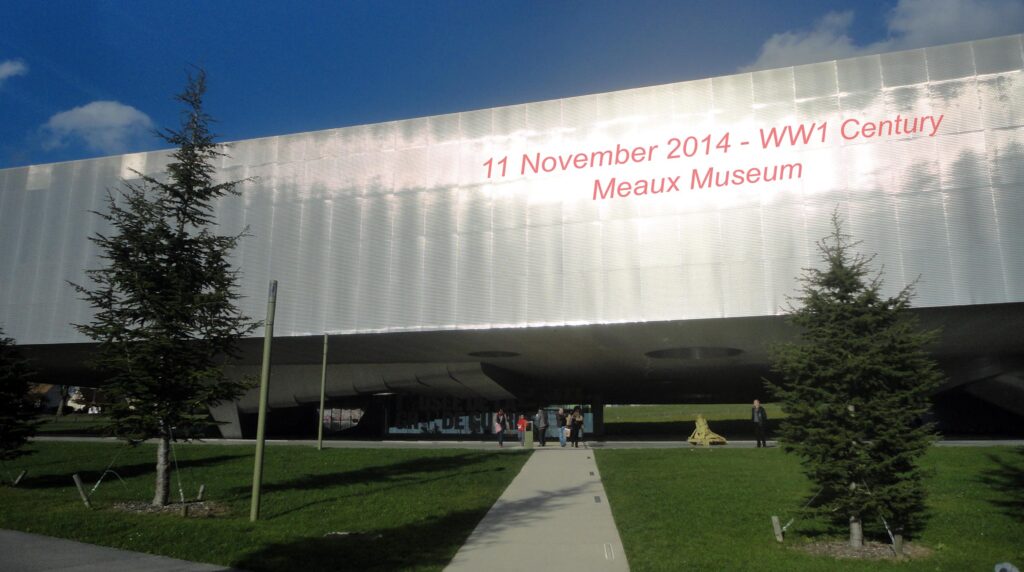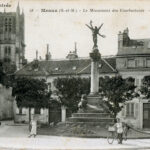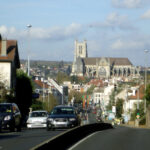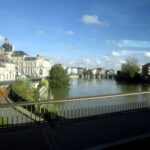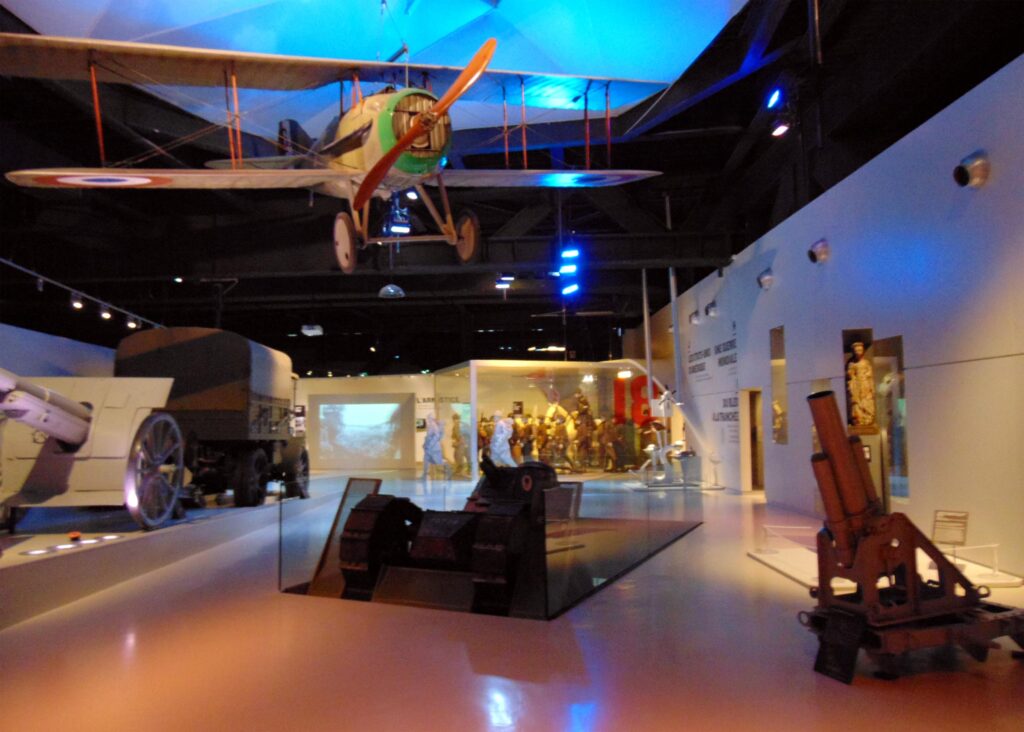First World or Great War Museum in France (French: Musée de la Grande Guerre) in the city of Meaux (Ile-de-France) was opened on November 11, 2011.
The city of Meaux is located in Ile-de-France, northeast of Paris. This was the maximum point where the Germans reached at the beginning of the First World War in the direction of Paris and then rolled back a little, after the so-called. “Miracle on the Marne”.
- WW1 battlefield city Meaux
- Meaux city and cathedral
- River, bridge and embankment
The visiting of the museum exposition and a the self-guided tour may be in two versions: chronological or thematic, depending on the interests of the visitor.
Great War Museum Meaux Tour Guide
How you can see the museum collection, the tips
Option I. Tour of the museum according to the chronology of events
WW1 Battle of the Marne, 1914
Discover the events of the first months of the war through a collection of uniforms and historical materials dating back to the 1914 period. Mobile warfare.
Uniform of the period 1914.
In this impressive space, the museum has collected uniforms for the first month of the war. Uniforms and weapons of French, German, Belgian and British soldiers. They illustrate the first battle of the Marne. On September 5, 1914, the Germans are on the doorstep of Paris, and the Allies are mobilized to defend the capital. The battle took place on a 300-kilometer front running from Senlis to Verdun. The Germans were surprised by the heroism of the French resistance and retreated. The heroic struggle of the Russian two armies in East Prussia contributed to the withdrawal of German reserves in the direction of Paris. This was the first victory in the Battle of the Marne! The German “opening door” plan did not work.
Marne Taxi from Paris
The rapid transport of German troops from the advancing 1st Russian Army in the area of Koenigsberg against the 1st Russian Army was the main cause of the disaster in East Prussia, known as the “Battle of Tannenberg”. The French command understood the importance of the rapid deployment of troops and applied a unique military operation using the mobilization of taxi cars in Paris. The museum exposition dedicated to this event begins with the exhibit “Renault Taxi Type AG”. This car is a symbol of the Battle of the Marne, part of which took place in the city of Meaux. On September 6 and 7, 1914, on the orders of General Gallini, about 600 Parisian taxis were requisitioned to send reinforcements to the front. The men, infantry soldiers of the 103rd and 104th infantry regiments, received 4 or 5 vehicles of them as a vehicle to go to Villemonble and Gagny to get to the battlefields in Nanteuil-le-Haudouin and Silly-le-Long. Although these numbers remain modest compared to the scale of the battle, and most of the troops joined the front by rail, taxis quickly become a symbol of the French battle and the national conscription that lead to victory.
Aviation in the First World War.
The lack of information about the transfer of German troops also played a fatal role in the East Prussian disaster of the 2nd Russian army. Aerial reconnaissance of the enemy position allowed the French army to avoid mistakes on the Eastern Front. The aviation exhibition begins with the original Blériot XII-2 aircraft. With its 10 meter wingspan and a top speed of 110 km/h, the two-seat monoplane Blériot XI-2 is one of the first military aircraft in the world. It comes from the plane with which Louis Blériot crossed the Canal in 1909. In the first months of the war, this model was used for surveillance and reconnaissance. A total of twenty-one French, British and Italian squadrons will fight. These aircraft will later be quickly replaced by more reliable ones that will be better adapted to the new military aviation missions. This rare exhibit is on loan from the Air and Space Museum at Le Bourget.
The God of the War, Artillery
75 mm caliber gun model 1897, This exhibit, a 75mm cannon, was made by the French army at the beginning of the war. The item marks a decisive step forward in field gun design. In fact, thanks to the elastic link that neutralizes recoil, allowing it to increase its rate of fire. A very powerful, 47 mm gun was considered by French strategists as a “universal tool”. But all these qualities faded quickly and proved unsuitable in the face of heavy German artillery in trench warfare. The exhibit is provided by the Draguignan Artillery Museum.
Trench warfare
The war is stuck! The war of attrition was embodied in trenches symbolizing this terrible conflict. Museum corner of this period of the war. Firstly, a sequence of individual shooting cells is visible, and then connecting narrow gutters – the trenches are designed to protect the fighter. Secondly, faced with the impossibility of resuming the war, a complex engineering defense system was organized, and on the other side of the neutral land, sometimes only from tens of meters you can see the enemy, and up to this distance he remains invisible. Between massive murderous attacks, each opposing side takes care to fortify its position. Barbed wire entangles the entire space between opponents. Engineers of all countries are beginning to think about creating a device that overcomes barbed wire and destroys the enemy in the trenches. Russian soldiers of the expeditionary corps in Champagne* also fought in the same trenches shown in the museum.
The Battle of the Marne, 1918
The soldiers climbed out of the trenches. The war on the battlefields resumed. The British stole the design of the Russian engineer Lysyakov and made the first Mk Rhombus tank, designed to break through wire obstacles and fire at enemy trenches. The world’s first tank attack, rather unsuccessful, took place. Two side turrets in sponsons, a crew of 11, terrible heat when the engines were running… The French made the world’s first tank with a classic layout – one rotating turret on top. The museum presents the legendary tank FT Renault (1917)
The FT tank was designed by Louis Renault at the “instigation” of Colonel Etienne. This heavy-duty, lightly armored, mass-produced tracked vehicle accompanied and supported the infantry on the battlefield. It was a fast and innovative tank: the armament was mounted on a 360° rotating turret, and the crew consisted of two people – the driver and tank commander.
The first battle of Renault tanks took place on the Chaudun plateau near Soissons on May 31, 1918. Its massive use by the Allies effectively contributed to the destruction of the German lines and the resumption of the war with advancement deep into the enemy defenses. Illegal copies of the Renault FT-17 tank became the first Soviet tanks under the name “Freedom Fighter Comrade Lenin”.
The exhibit in Meaux comes from the Tank Museum in Saumur (Loire Valley).
The War in the air.
Since the beginning of the war, aviation has increasingly been used not only for reconnaissance purposes, but also as an air means of defeating the enemy. A rare Spad XIII model is presented in the hall.
During the Great War, fighter jets were used as a tool for warfare in the skies. Increasingly powerful aircraft were built, such as the SPAD XIII, a single-seat biplane with two machine guns, which was designed in 1917. This aircraft, with a wingspan of more than 8 meters, could fly at a speed of 230 km / h. It was in service with 81 French squadrons from the summer of 1917, as well as in the service of a number of foreign units. It would remain the main fighter of the French army until 1923. The aircraft has the tactical designation and coloring of Captain René Fonch, who by the end of the war had 75 recorded victories. The artifact is also provided by the Air and Space Museum in Le Bourget.
Uniform and weapons at 1918
If the uniform in Russia since 1914 has changed only in the style of pockets, the introduction of fashionable English “jackets” and the appearance of the first and rare helmets of Adrian, then the Allies have undergone more significant changes, especially in the French army. This hall with dummies displays the uniforms of French, German, Italian and American soldiers during the battles of the summer of 1918. Echoing the style of the 1914 Battle of the Marne exhibition, this section shows the evolution of uniforms and armaments after four years of global conflict.
Modern Art.
Military museums have their own specifics and are very conservative in the way they present exhibits. But life goes on, and after multimedia and visualization, contemporary art is also being introduced as a separate exposition.
Sculptures by Jean-Louis Fauré, collection in the museum.
Jean-Louis Fauré is a contemporary sculptor. His works are presented as groups of different objects, reconstructed and lofty, in the style of the work of Marcel Duchamp, whose humorous and provocative tone is also present here. These creations form atypical groups, without plinth or pedestal, unclassified objects that are difficult to reproduce or display in a museum. A longtime friend of Jean-Pierre Verney, the artist is committed and marked by his anti-militarist outlook, he feeds his work with anecdotes and historical references to the great events of the twentieth century (World War I and II). The Great War is one of the recurring themes in his work.
Contemporary art at the center of the museum is part of the approach in the scientific and cultural project of the institution. The museum aims to provide insight into today’s perspective on the memory of the conflict.
In December 2015, the artist donated four of his works to the museum. The museum hall was designed so that the sculptures integrate with their environment in a consistent way, each reflecting the space in which it is located.
Russian soldiers as part of the Expeditionary Corps actively participated in France. The Museum has an exposition dedicated to the Russian Imperial Army, when it was still the allies of France, the USA and Britain, before the Bolsheviks seized power.
Option II: alternative tours in the museum (thematic)
Room A. German camouflage helmet. New, “trench” war
This German stalhelm, literally meaning “steel helmet”, is in the new military section. Originally designed to protect the fighter from being detected by enemies, camouflage was developed during World War I due to countering aerial reconnaissance and was applied to all areas: artillery, vehicles, warehouses, aircraft, warships or merchant ships … Throughout the war, camouflage more and more improved.
Room B. War and children. general mobilization. Panorama.
In August 1914, millions of men between the ages of 18 and 45 took up arms. Cities and villages were empty and many teenagers appeared in them. Women, children and the elderly should live normal lives and participate in the war in various ways. With minimal help around the house, teenagers work in the fields or in factories. Under the supervision of school teachers, children are encouraged to imitate their fathers, they played and in their games showed their gratitude through the patriotic activities in which they participated – parades, quests, etc. Military patriotic education and actions.
Room C. Manufactory. Plants and factories. Women.
Production tour. From September 1914 stocks of shells were reduced due to their huge use in the first weeks of the war. Thinking that there would be a quick short war, there was no planned production program for the war effort. At the end of 1914, production resumes, and women join the artillery factories. The workers were nicknamed “munitionnettes” (“ammunition”) and producing 2,500 75 mm shells each, which weighed 4,500 kg of metal, worked in difficult conditions for 14 hours a day.
Room D. Trench life. Helmet mandala.
This object, made in the trenches, is a tool of luck made from the scraps of military life. Indeed, although the handle is made from a real musical instrument, the sound box is made from the base of Andrian’s steel helmet (a French helmet also supplied for Russia). In the trenches, playing or listening to music is a way for the brain to survive and not go crazy. Tools are brought by soldiers by soldiers or sent by their families, others are bought or kept at the front. Some improvised instruments are handmade from readily available material. of them are made by improvised tools with affordable means. These instruments, ranging from primitive bodies to highly artistic pieces, accompany people who in this way bring some music and human values back into their daily lives.
Hall F. Disabled people, prostheses, insurance
Prostheses during the Great War served to ensure that many disabled people without arms and legs could feel better in society. Caring for the disabled is a sacred duty of the state. Tools for this purpose were constantly improved in accordance with the needs of war victims – several research projects were developed dedicated to the development of prosthetic legs, knees or hands, etc. This exhibition once again reminds us that war is very bad and scary.
Room H World War. Japanese infantry uniform for 1914
Infantry uniform of the Allied Powers of the Entente after the Russo-Japanese War (1904-1905). Japan declares war on Germany on August 30, 1914 and becomes an ally of Russia. For Japan, this was an opportunity to expand its influence in Asia by taking over the German colonies. At the beginning of the 20th century, the Japanese army was reorganized and its uniforms were modernized. The so-called M.45 uniform set, worn from 1913, consisted of a khaki uniform. The uniform of the Japanese soldiers was practical and very well-equipped, arousing the envy of European infantry soldiers. At the end of the war, such uniforms, equipment and weapons even came to the Russian army from the Japanese ally.
Room I Uniform of the Senegalese Riflemen. From blanket to trenches
The French army included units made up of soldiers recruited from the French colonies in North Africa. The “black power” propagated by General Mangin and which the German state meters consider unworthy of a civilized country. These regiments of “Senegalese Riflemen”, actually recruited from all over North Africa, proved to be formidable combatants. Often used as shock troops, their casualties are still slightly lower than those of mainland French soldiers. Russian brigades in France were just attached to these exotic units.
Showcase J, US Army
USA. At the start of the war, there was only a small volunteer army in the United States that did not have powerful weaponry. The first wave landed at St. Nazaire on June 26, 1917, on the orders of General Pershing, and was received with enthusiasm. But at the end of November 1917, American troops were still only 180,000 strong. Germany sponsored the Bolsheviks and Lenin, decomposed the Russian army and brought Russia out of the war. Obscene Brest Peace. But from July 1918, more and more Americans began to arrive on the Western Front. They landed 250,000 soldiers a month. On the day of the November 11, 1918 armistice, there were about 2 million Americans in France.
There are other sequences of visiting the museum in accordance with the hobbies and preferences of the visitor.
The Practical tourist information, the useful tips and reviews
Opening hours of the Museum of the First World War:
From May to September – daily from 9:30 to 18.30
From October to April – daily from 10.00 to 17.30
Day off – Tuesday. Closed – January 1, May 1, December 25
The ticket office and the entrance close 30 minutes before the closing time of the museum
Entrance ticket price – 10 Euro, exhibitions – 5 Euro
Considering that almost all museums in Paris are closed on Mondays, you can use Monday in the program of your tour for this interesting and unusual museum.
How to get from Paris.
- Public transport, the train + local taxi, the problems and the advices.
- Private tours by a car from Paris hotel or Charles de Gaulle airport (Disneyland, Orly)
- Museum visit on the way to Champagne (sightseeing trip) for one day
- WW1 battlefield private tours to Verdun Citadel for 3-5 days

